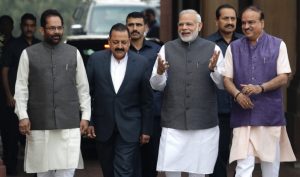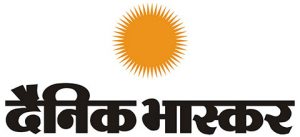
13-04-2017 (Important News Clippings)
To Download Click Here
संविधान के अनुकूल नहीं है संघ प्रमुख की दलील
Misreading caste
New backward classes commission perpetuates an older truncation—of exclusion and discrimination as merely deprivation and disadvantage.

The answer to this question depends on the precise differences that will distinguish the proposed body from the existing one. While there is (as yet) no authoritative statement on this issue, reports in the print media suggest that the NCSEBC will be a constitutional body (like the commissions for the Scheduled Castes and Tribes) rather than a statutory body (like the NCBC). This legal distinction is not very consequential in terms of the practical functioning of the proposed commission, but it could have important political implications. The possible impact of the change will depend on whether the Modi regime’s future agenda on this issue is modest or ambitious.
A modest agenda will limit itself to placing the NCSEBC on par with the National Commission for the Scheduled Castes (NCSC) and the National Commission for the Scheduled Tribes (NCST). Legally, this would require amendments to the Constitution, introducing additional Articles comparable to the existing Articles 338 and 338A (which establish the NCSC and NCST respectively), and 341 and 342 (which lay down the procedure for initially notifying and subsequently amending the list of castes, tribes or social groups identified in specific states and Union territories as belonging to the Scheduled Castes and Scheduled Tribes respectively).Politically, this effects two major changes: First, it shifts responsibility for amending the list of Other Backward Classes (OBCs) from the government to Parliament; second, it effectively takes away the power that the states currently have to determine their own OBC lists.Most reports suggest that this is what the government intends to do. The obvious political benefit of this move is that it denies opponents a free ride on the aspirational demands of electorally significant castes like the Jats, Marathas, Patidars or Kapus. Since it is Parliament that would have to decide whether to grant OBC status, it would no longer be possible for opposition parties to stoke agitations without bearing responsibility for the consequences. Moreover, the burden of handling the inevitable conflicts arising from a zero sum situation — where the entry of new castes necessarily implies a decline in the share of castes already included — could also be shifted from the ruling party to Parliament.
This is a modest agenda because it does not alter the basic rules of the game, namely the definition of the category “socially and educationally backward classes”, and the existing limit of 50 per cent on the total share of various reservation quotas imposed by the Supreme Court. In fact, this agenda could arguably be considered a positive step, especially if it includes much-needed provisions for sub-dividing quotas to ensure more equitable sharing across the sub-groups of recognised categories.The danger, of course, is in the possibility of a much more ambitious agenda. At least one press report has indicated that the government also intends to amend Article 366 of the Constitution (which contains basic definitions of important terms) by inserting a definition of “backward classes”. Currently, Clauses 24 and 25 of this Article provide a conservative definition of the SCs and STs as simply the entities included in the Schedules created by the constitutional method specified in Articles 341 and 342. While constitutional experts would have the final say, is it premature to speculate on the possibility of a substantive change in the definition of OBCs that goes beyond its current confinement to social and educational criteria?
Such a recklessly adventurist agenda could include the extension of reservation to not only dominant castes like Jats, Marathas or Patidars, but also “economically backward” upper castes. This would entail introducing legislation to lift the ceiling on quotas beyond the 50 per cent level, and formalising economic criteria, both of which have been strongly resisted by the judiciary. The electoral gains are clearly substantial, apart from the long-term benefit for the ruling party of retaining its upper and dominant caste constituencies without alienating the new adherents it may have acquired within the backward castes. This course of action is so unwise that optimists would be forced to believe that it is unlikely. But given that the Pradhan Sevak’s charisma seems to rely on the application of an Obama-like slogan — “Yes we can!” — to a Trump-like agenda, we cannot confidently rule it out.
In sum, the modest agenda would protect reservations as a tiny and increasingly irrelevant island in the neoliberal ocean of jobless growth, while the ambitious agenda would reduce reservations to absurdity in ways that will inevitably impact the SCs and STs. But both courses of action are framed by the larger contradiction in the Indian state’s attitude towards caste — the wilful misrecognition and truncation of exclusion and discrimination as merely deprivation and disadvantage.
By treating reservation as a welfare programme and covering up social divisions with the language of backwardness, we have deceived ourselves so thoroughly that we are no longer capable of naming things for what they are. When it comes to social discrimination and inequality, it would be dishonest to blame the current regime alone. For example, a rational and objective application of the current social and educational criteria would show that Muslims (specially urban Muslims) are unquestionably a group deserving state support today. And yet, our past and present governments have conspired to produce a present where it is not only unthinkable that Muslims will get reservation, but quite conceivable that gau rakshaks may get it.
Pivot to the Indo-Pacific
Cooperation with like-minded countries gives India more space to emerge as a key regional interlocutor

Positive trajectory
There are now new demands being made on India. And New Delhi seems ready to play ball. Its role as a security provider is visible in the Delhi-Dhaka joint statement which has stressed the need for greater military-to-military training and exchanges, and complimented the armed forces for their professional conduct during joint search and rescue operations in the Bay of Bengal leading to the rescue of a large number of fishermen from both sides. The defence relationship was the highlight of Ms. Hasina’s visit to Delhi this time as it included a memorandum of understanding on a defence framework, and a $500 million line of credit (LoC) for defence procurement by the Bangladesh military forces, the largest such LoC India has extended to any country so far. What makes this line of credit more significant is that Bangladesh will not be bound to use it to source its supplies only from Indian companies. This is India’s way to reposing confidence in the Hasina government that it will not challenge New Delhi’s vital interests.
India is also ready to demonstrate it keenness to share its economic growth with its regional partners. It is also extending a $4.5 billion line of credit to Bangladesh, over and above the existing $2.8 billion line, to fund around 17 infrastructure projects which includes port upgradation work at the Mongla, Chittagong and Payra ports. Given the critical need for enhancing connectivity in South Asia, India is pushing for early implementation of the Bangladesh-Bhutan-India-Nepal (BBIN) Motor Vehicles Agreement, aimed at facilitating seamless transport of goods over land customs stations. Bus and train services between Kolkata and Khulna have been started, and there are plans to revive inland waterway channels.
Prime Minister Narendra Modi and Ms. Hasina have both been instrumental in shaping the positive trajectory of this important bilateral relationship. Mr. Modi used his political capital to push through the land boundary agreement (LBA), to swap enclaves India and Bangladesh held in each other’s territory, in 2015 and is working towards mitigating differences on the critical Teesta water sharing pact. Ms. Hasina has been equally responsive to Indian concerns. Bangladesh is taking serious steps to deal a decisive blow to separatist Indian insurgent organisations such as ULFA and the National Democratic Front of Bodoland. There is now greater convergence between India and Bangladesh on dealing with fundamentalist forces such as the Harkat-ul-Jihad al-Islami, the Jama’atul Mujahideen Bangladesh and Harkat-ul-Ansar.
For her commitment to strong Delhi-Dhaka ties, Ms. Hasina has faced a lot of opposition at home. Soon after New Delhi and Dhaka signed 22 pacts in key sectors, Bangladesh’s Opposition leader, Khaleda Zia, accused Ms. Hasina of “selling out” the country to India to translate into reality her “dream of staying in power for life”. Given the size and scale of India, it inevitably becomes part of the domestic political milieu in its neighbouring states. So it will always have to trudge cautiously in South Asia where suspicions about New Delhi’s intentions run high. But the more India is seen to be reciprocating its neighbours grievances, the better chances it will have of mitigating these tensions.
The other way out for India is to enhance its engagements in the larger Indo-Pacific, thereby getting out of the straitjacket of being a “mere” South Asian power. New Delhi’s success in engaging countries such as Japan, Australia, Vietnam, Malaysia and Indonesia in recent years is testament to the growing demand in the region for a larger Indian role and presence. Mr. Turnbull’s visit to Delhi this week once again showed that India is now widely perceived to be a strong and credible regional force. The two countries pledged to enhance maritime cooperation as they underlined “the importance of freedom of navigation and overflight, unimpeded lawful commerce, as well as resolving maritime disputes by peaceful means, in accordance with international law, including UNCLOS (United Nations Convention on the Law of the Sea)”.
Defence cooperation once again is at the centre of this relationship with the decision to hold a bilateral maritime exercise named AUSINDEX in 2018. A bilateral exercise of the Special Forces will be held later this year, while the first bilateral army-to-army exercise will also take place in 2018. The two countries should now prioritise the conclusion of the Comprehensive Economic Cooperation Agreement (CECA) at the earliest to give economic heft to their growing security interactions.
Despite the hype about the possibility of India emerging as the guarantor of the liberal economic and security order in Asia, there are now new possibilities for reimagining New Delhi’s regional and global role. Greater cooperation with like-minded countries in the region and beyond will give it greater space to emerge as a credible regional interlocutor at a time when Washington’s policies remain far from clear and Beijing is challenging the foundations of the extant order.
Harsh V. Pant is a Distinguished Fellow at Observer Research Foundation, New Delhi and Professor of International Relations at King’s College London
Date:12-04-17
More robots, fewer jobs?
Lately we have been inept at creating new employment-generating sectors

Bridging this employment gap could become an insurmountable challenge thanks to the growing integration of machine learning and artificial intelligence (AI)-based technologies and robotics in all our core industrial sectors.
Currently, various automation technologies are in the process of overhauling the mass employment-generating but low-skilled blue-collar labour markets. They could also threaten skilled white-collar workers. For instance, JP Morgan Chase and Co. recently developed a programme called COIN, a learning machine that interprets legal agreements in just a few seconds, a task that consumed 3,60,000 work hours for lawyers and loan officers annually. Similarly, an American medical school tested IBM’s AI technology Watson to analyse 1,000 cancer diagnoses. In 99% of the cases, Watson was able to recommend treatment plans that matched the suggestions of well-renowned oncologists. Suddenly, the World Economic Forum’s estimate that automation threatens almost 69% of the existing jobs in India seems like a conservative number.Throughout history, we have always feared that machines will cause mass unemployment. “In every kind of endeavour, in office work as well as industry, in skilled labour as well as common tasks, machines are replacing men, and men are looking for work,” John F. Kennedy had said in 1960. However, this never happened as once old jobs became obsolete, new ones evolved. Machines decreased costs and prices, boosted demand, and created more employment opportunities. In India, for instance, as jobs started dwindling in farms, more productive sectors like manufacturing and services emerged.
Creating employment opportunities
However, lately we have been inept in creating new employment-generating sectors while machines are systematically cutting down the workforce requirements in the principal labour-generating triumvirate of agricultural, manufacturing and services sectors. This will be one of our foremost challenges. Even if we rise up to it, a majority of the jobs absorbing our labour requirements will be ones that do not currently exist. If most of our future jobs are expected to come from the services sector, it is also imperative to impart social and communication skills along with the requisite domain expertise to ensure the creation of a market-ready workforce. The success of the Modi government’s Skill India mission will turn out to be vital in the prevention of social inequalities that are bound to arise because of our current unemployment trajectory.
Anil K. Antony is the Executive Director of an Indo-American think tank in cybersecurity, intelligence and surveillance technology. Tweets @anilkantony
किसानों से अब भी दूर है फसल बीमा योजना
पिछले साल की तरह इस साल भी अप्रैल की बेमौसम बारिश, ओलावृष्टि और तेज हवाओं ने रबी की फसल व बागवानी को काफी नुकसान पहुंचाया। इस प्राकृतिक आपदा ने पहले से बदहाल किसानों की परेशानियां बढ़ा दी हैं। उत्तर भारत में जम्मू-कश्मीर, पंजाब, हरियाणा, उत्तर प्रदेश और मध्य भारत में विदर्भ के किसान इससे ज्यादा प्रभावित हुए हैं। अब लाखों किसान सरकारी कार्यालयों और बीमा कंपनियों के चक्कर काटने को विवश हैं।
किसानों की फसली अनिश्चितताएं दूर करने के लिए केंद्र सरकार ने 13 जनवरी, 2016 को प्रधानमंत्री फसल बीमा योजना मंजूर की थी, जो जून, 2016 से लागू भी हो गई। योजना के तहत बहुत कम प्रीमियम पर फसलों का बीमा होना था। प्राकृतिक आपदा, कीट-रोगों की स्थिति में किसानों को पर्याप्त बीमा कवरेज और वित्तीय सहायता मिलनी थी। यानी इसके लक्ष्य अच्छे थे।
योजना लागू हुए एक साल से ज्यादा हो गया है। अब तो इसकी खामियां भी उजागर होने लगी हैं। हालांकि यह खेती को मुनाफे का सौदा बनाने व गांवों की अर्थव्यवस्था में निवेश के लिए सही दिशा में उठाया गया कदम था, पर कुछ निजी कॉरपोरेट कंपनियों द्वारा इसे कमाई का साधन बना लेने से किसानों को सही लाभ नहीं मिल पा रहा। योजना बनाते समय सरकार ने निजी बीमा कंपनियों पर अतिरिक्त भरोसा जताया, जो अब योजना के क्रियान्वयन में सबसे बड़ी बाधा है। न जाने क्यों सरकारी बीमा कंपनियों को इससे दूर रखा गया है? बीते दिनों प्राकृतिक आपदा से 45 बीघा फसल के नुकसान के बाद पटवार, मध्य प्रदेश के एक किसान को फसल बीमा लेने के लिए आमरण अनशन करना पड़ा था। इसके बाद भी उसे लाभ नहीं मिला, क्योंकि विभाग ने खेत को इकाई न मानते हुए पूरे हलके को इकाई मानकर उसके नुकसान का आकलन नहीं किया। दरअसल, किसानों को लाभ पहुंचाने वाली ज्यादातर योजनाएं अक्सर नियमों की विसंगतियों के कारण कारगर साबित नहीं हो पातीं। इस मामले में भी ऐसा ही है।
योजना के तहत खरीफ के लिए पंजीकरण की अंतिम तारीख 31 जुलाई के आस-पास होती है। तब तक मानसून का रुझान साफ हो चुका होता है। ऐसे में, इस साल कमजोर मानसून का पूर्वानुमान रहने पर बीमा कंपनियों को भारी दावों का सामना करना पड़ सकता है। पिछले खरीफ सत्र में महाराष्ट्र से करीब 4,000 करोड़ रुपये का प्रीमियम जमा हुआ था, जबकि दावा 2,000 करोड़ रुपये का था। यानी पिछले वर्ष बीमा कंपनियों ने मोटा मुनाफा कमाया, मगर गरीब किसान की स्थिति नहीं बदली। ताजा रिपोर्ट बताती है कि इस साल कमजोर मानसून के पूर्वानुमान के चलते कई निजी बीमा कंपनियां पहले ही महाराष्ट्र से पलायन के चक्कर में हैं। दरअसल, कंपनियों के लिए यह योजना महज लूट का माध्यम है। कंपनियों को फसल कटाई व नुकसान के आकलन के लिए कर्मचारी रखने समेत बुनियादी ढांचा तैयार करने पर कोई प्रारंभिक निवेश नहीं करना पड़ा है। पहले से ही अत्यधिक बोझ से दबे कृषि विभाग के कर्मचारियों द्वारा आकलन में लगाई गई मेहनत का भी फायदा ये कंपनियां उठा रही हैं। हरियाणा, राजस्थान जैसे कई राज्यों में किसानों के खातों से प्रीमियम राशि जबर्दस्ती काटे जाने की शिकायतें मिली हैं। राजस्थान में तो किसानों की खाली पड़ी जमीन का भी प्रीमियम काट लिया गया। औसतन जहां किसानों ने पांच से सात सौ रुपये तक प्रीमियम दिया, वहीं पूरी फसल खराब होने के बाद भी उन्हें मुआवजे के तौर पर 13 से 20 रुपये मिले।
निस्संदेह, इस योजना की कुछ खामियां दूर कर ली जाएं, तो इसके अच्छे परिणाम मिल सकते हैं। सबसे पहले तो बीमा कंपनियों की मनमानी रोकनी होगी। हर आपदा अपने साथ बेहतरी का अवसर भी लाती है। हाल ही में हुई ओला वृष्टि और असमय बारिश का जो असर किसानों पर पड़ा है, वह नीति में सुधार करने का एक ऐसा ही मौका है। केंद्र व राज्य सरकारों को कृषि विकास के लिए साझा सतत और टिकाऊ नीति बनानी चाहिए। भारतीय कृषि और किसानों के लिए एक ऐसी व्यवस्था जरूरी है, जो भविष्य में किसानों को फसल क्षति की स्थिति में उचित मुआवजा और बीमा राशि बिना किसी अड़चन के दिला सके। (ये लेखक के अपने विचार हैं)



